Moya, Minnie and I decided to start off with a project perfect for fall. A pumpkin loaf made with real pumpkin, oatmeal and scented with an EO blend of Orange, Cinnamon and Clove.
Pumpkin Hot Process Soap Recipe
Palm oil – 8 oz
Coconut oil – 8 oz
Olive oil – 8 oz
Sunflower oil – 4 oz
Mango butter – 2 oz
Castor oil – 2 oz
Canned pumpkin – 10 oz
Water – 2 oz
Lye – 4.48 oz (6% SF)
Sodium lactate – .5 oz
2 tablespoons ground oatmeal
1.5 oz blend of orange, cinnamon and clove essential oils
Step 1 – Make the lye solution. We decided to use canned pumpkin in place of water to give our pumpkin soap a wonderful baked pumpkin bread color. Make sure you used canned pumpkin that is just pumpkin! Check the ingredients. You don’t want to get pie filling that is full of sugar and other stuff. Mix 10 oz of pumpkin with 2 oz of water and add the lye slowly while stirring well. I set ours in a cold water bath so it wouldn’t burn.
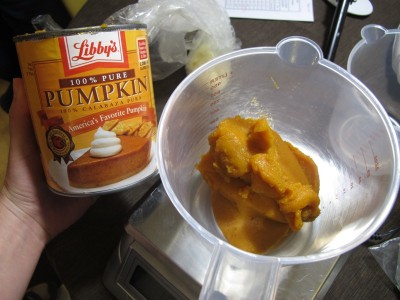
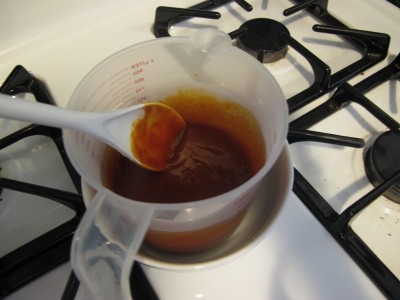
Step 2 – Measure out the oils into your crock pot. Go ahead to turn on your crock pot to high. Here’s a time saving tip from Moya. If you aren’t using any brittle or really hard oils or butters such as cocoa butter or palm kernel you don’t really have to worry about melting them. Of course if it’s cold where you live and your palm and coconut oil is super hard…go ahead and melt. But if your oils are nice and mooshy…don’t worry about it. So measure out all of the oils and butters and stick blend to mix smooth.
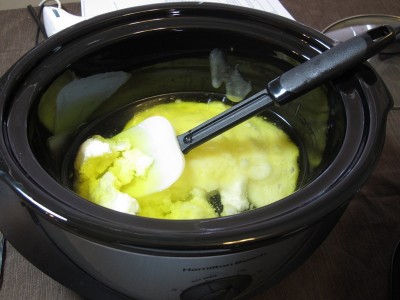
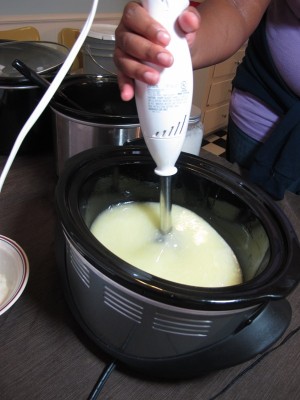
Step 3 – Add the sodium lactate to the lye water/pumpkin puree. Don’t worry about the temps when you’re hot processing. You don’t have to worry about the lye cooling down. Add .5 oz of liquid sodium lactate.
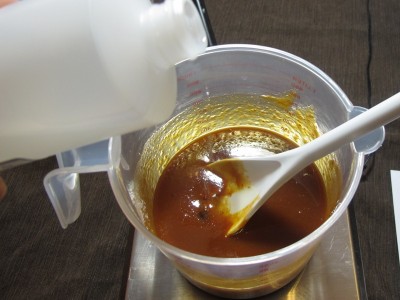
Step 4 – Gear up in goggles and gloves! Pour the lye solution into the crock pot of oils and mix until you reach trace.
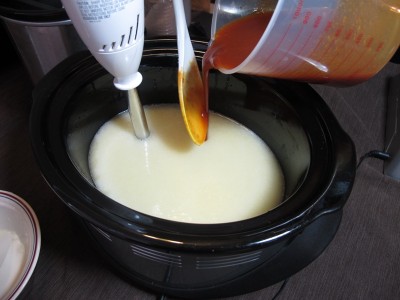

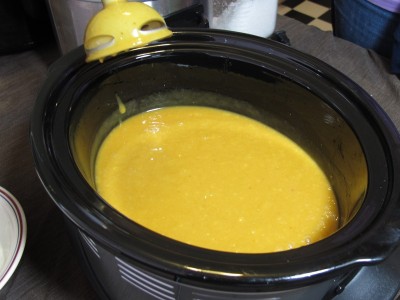
Step 5 – Put the lid on your soap and set to cook. If you are new to hot process soap or are trying out a new crock pot I recommend cooking your soap on medium or if your crock pot has just low and high…set it on low. One of the biggest mistakes when hot processing is over cooking the soap. We set ours to high which turned out to be too hot! But I’m glad we did because we can show you what CAN happen when you HP and show you how to fix it!
We set our soap to cook (on high) at about 2:50 pm. 15 minutes later…here is what we saw. You can see the edges starting to gel. You can also see a liquid on top that is generally thought to be a mix of glycerin and condensation that has dropped down from the lid.
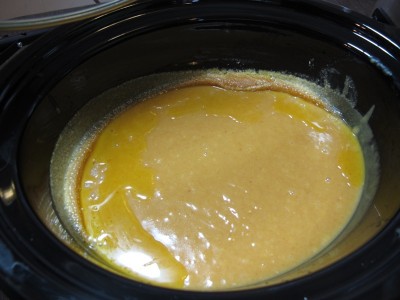
There are two types of hot processors…those that stir and those that don’t! I am one that doesn’t and so is Moya! We both simply wait for the soap to completely gel and do a poofy/turn type of dance (which you’ll see in the next soap) and then give a good stir and check for zap. Well this soap decided to separate a bit. So we went ahead and added our oatmeal and gave it a good mix.
I didn’t get a good picture of the initial small amount of separation. But here we are mixing and adding the ground oatmeal.
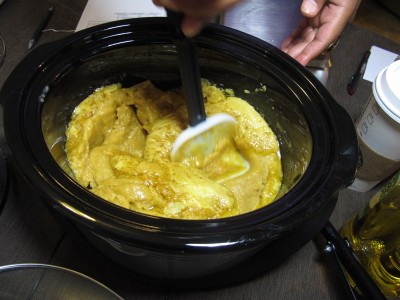
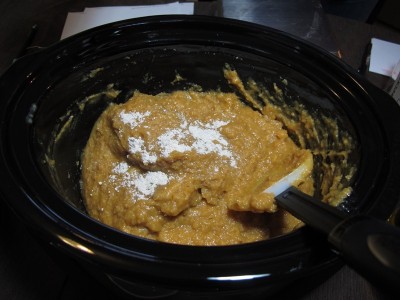
It’s better to add the oatmeal at trace. We just forgot.
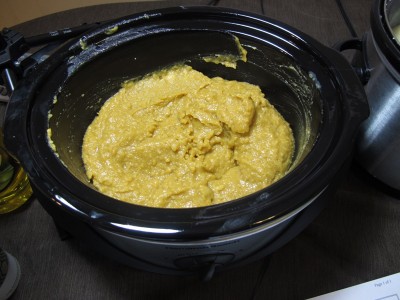
We put the lid back on the crock pot and decided to turn the crock pot down to medium. Separation is often times a sign of overheating.
About 15-20 minutes later we checked on it. EEK! We now had major separation!
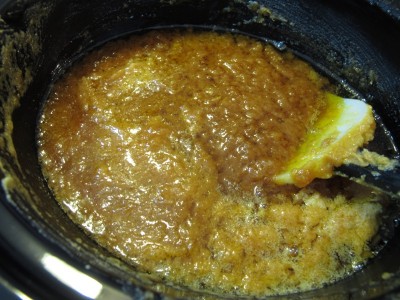
Alright. No big deal. Breath. And stickblend that baby back into emulsion!
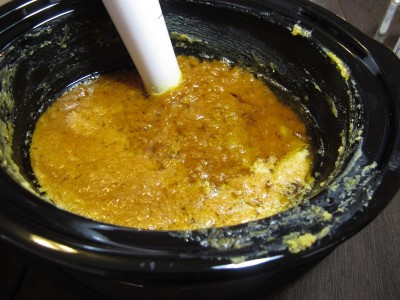
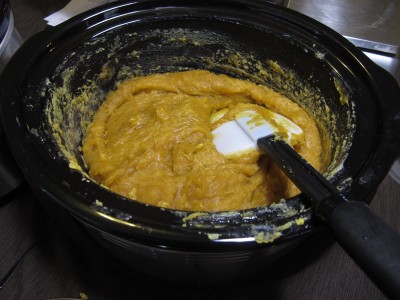
With our crock pot still on medium we let it cook for another twenty minutes and then tested for zap. To test for zap I like to take a craft stick, put a dab of the soap on it, blow on it to cool and harden and lightly touch it to your tongue. If you get a zap…the soap is not done. Let it cook for a bit longer. If you don’t get a zap then it’s done! Ours was done.
Moya decided to take the spatula over to the sink and test out the lather. Looking good!
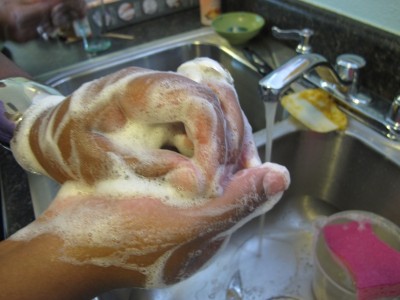
We took the temp of the soap and it was at about 200 degrees F. That’s a bit hot to add the essential oil blend to so we put the lid back on it, turned off the crock pot and let it cool down for about 15 minutes.
Once it was cooled down a bit, we added the essential oil blend and mixed well.
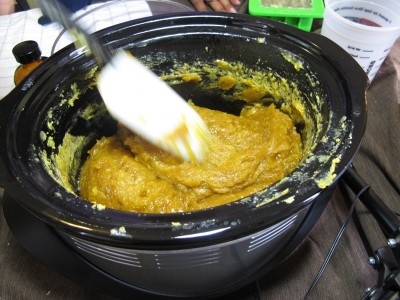
Then it’s time to pour it into your mold. Moya’s tip is to pack it down and smooth it down as you pour (or glop if your mix is thicker). This helps get rid of any air that might get trapped.
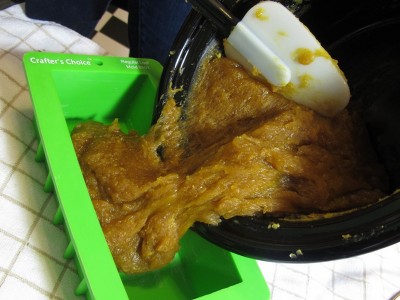
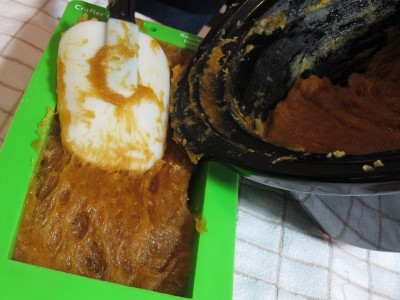
Again, push down and smooth as you go.
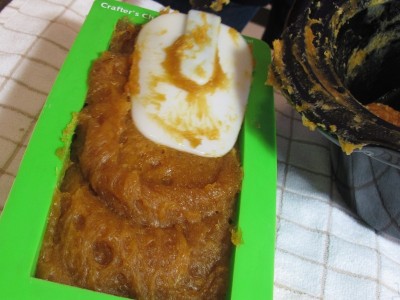
Moya decided to pack it up high, shape it like a loaf of bread and top with a bit of oatmeal!

Looking good!
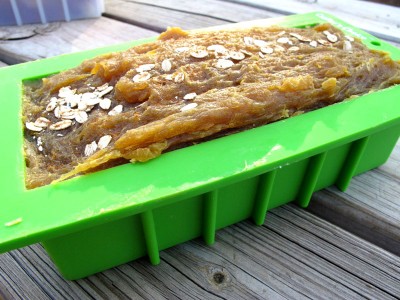
Unmolded 24 hours later…it does look like a loaf of pumpkin bread!
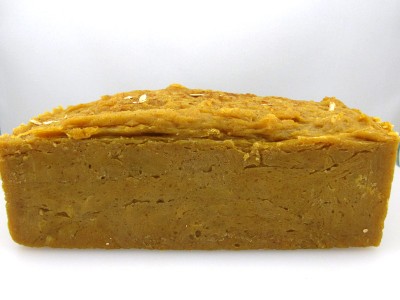 Slice it up and enjoy!
Slice it up and enjoy!
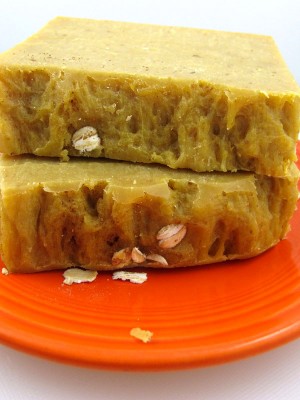
Check out how smooth it is! It almost looks like CP soap!
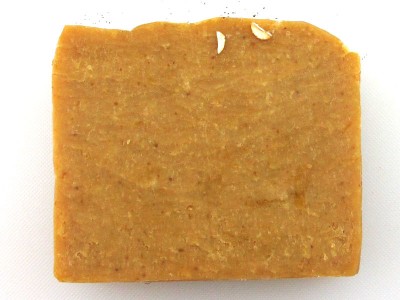
It is generally said that hot process soap does not need a cure and is ready to use right away. I do agree that you can use it right away but I think even hot process does good and gets much better with at least a two week cure. I don’t think there is a right or wrong…you’ll just have to decide for yourself.
Some hot process soap making tips:
- Use full water when calculating your recipes. This will allow for evaporation during the cook and help with a smoother pour. We actually discounted a bit in our recipes except for the pumpkin soap. Try full water then if you decide you want to discount…go from there. (Full water = whatever the online calcs spit back at you. If will vary by calculator.) I tend to think of full water as 3 times your lye amount.
- Don’t get hung up on “stages”. I notice that a lot of hot process tutorials mention the stages of the cook including mashed potatos, vaseline…etc. But in my experience you’ll see these stages or not depending on the mix of oils you are using.
*A note on sodium lactate. Sodium lactate comes in both powder form and liquid form. It is easily soluble in water should you choose to get the powder form. When I mention sodium lactate anywhere on my blog I am referring to the liquid form as that’s the only type I have used. Sodium lactate is a salt of lactic acid. Sodium lactate is used in hot process soap to help create a smoother pour and also harden up the soap.
Sodium lactate can be added to both hot process and cold process soap. Usage rates for the liquid sodium lactate are between 1-5% of oils. Moya mentioned that she uses it at the lower percentage in hard recipes (recipes that contain 50% or more of hard oils/butters) and higher percentages in softer recipes containing higher amounts of liquid oils such as olive, avocado, sunflower, apricot kernel…etc. She noted that using too much with a high percentage of hard oils results in a soap that is crumbly and flaky. I’ve noticed the same results when using it in cold process soap. I recommend starting with 1-2% and going up from there. 5-8% is when I starting getting the flaky crumbly results.
Sodium lactate can be a great additive when making hot process soap. Sugar is another great additive that I’ll talk about in a later post.
Coming up in the hot process series is a two toned beauty!
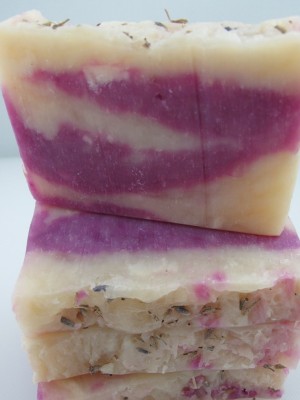
Until then…Happy Soaping!

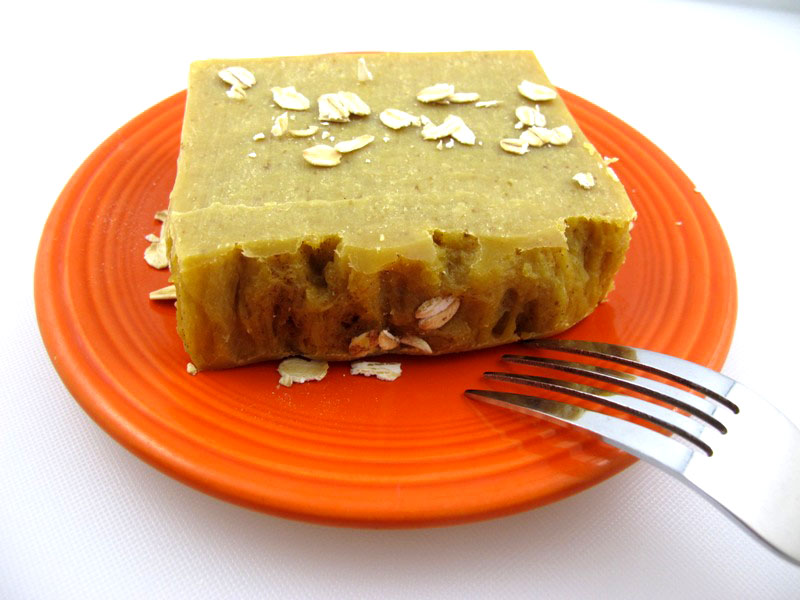
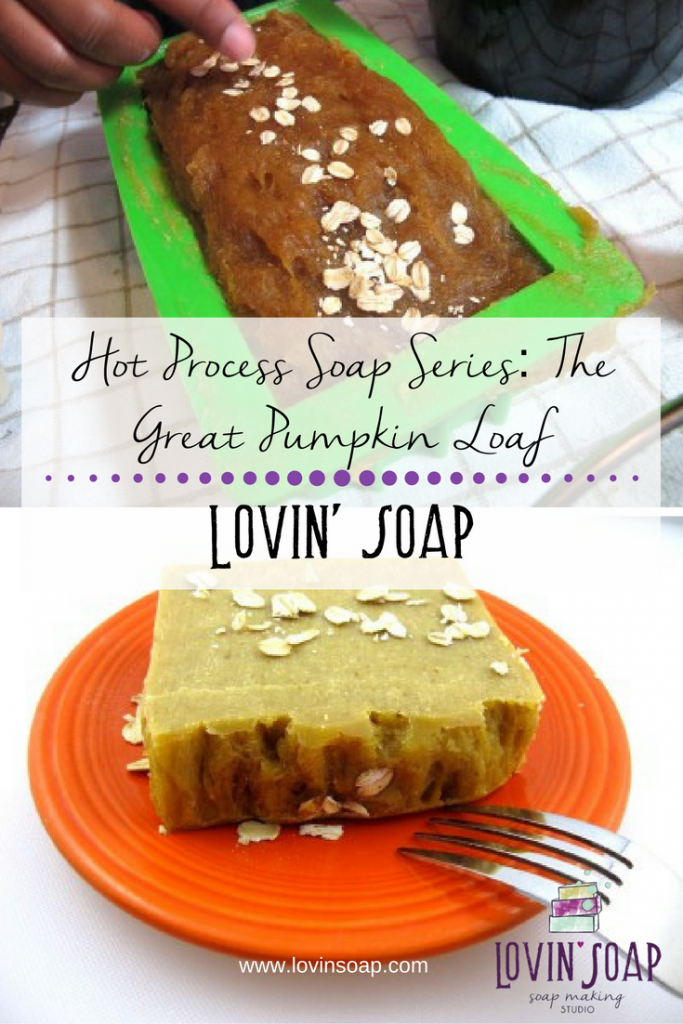

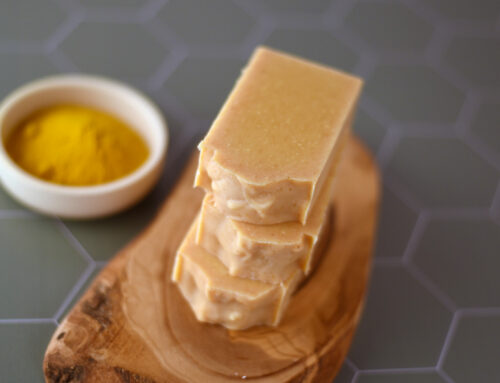
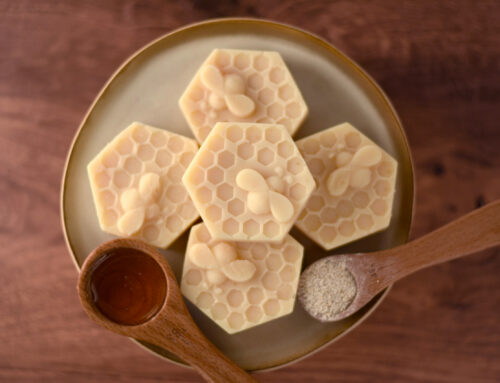
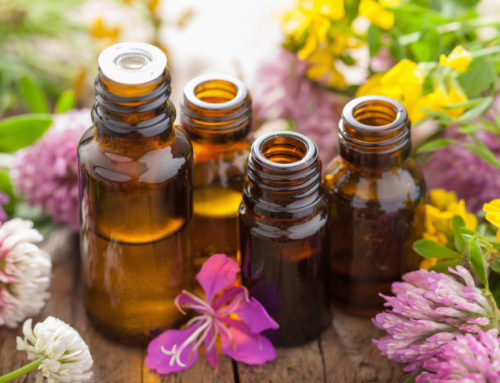

Very nice tutorial. Love the details. I love making HP soap. Haven’t tried the pumpkin though. Thanks for sharing.
Luxuriously Natural Soaps
Looks simply delicious! Nice tutorial!
Love the look! I had the same separation issue when I made a pumpkin soap a few weeks ago and when I did a cold process batch, I had an oily mess on the bottom (I cleaned everything up and the soap was amazing anyway). I wonder if it is something about the pumpkin that makes it do that. I had a crazy panic when I opened up my pot and saw what had happened, but my soap turned out beautiful! I’m glad I’m not the only one that had pumpkin problems.
I want to try this with Honey and Beeswax (i am a beekeeper), how much would you recommend?
Love you pictures and detailed instructions
Lizzy
Hi Lizzy! I would recommend one ounce per pound of oils of each honey and beeswax.
and i thought i could make it after going to the fair. this makes me think of the autumn pie at the texas state fair…now i need to make more pumpkin soap…what a mess! it looks great!!
Looks so edible and the fragrance sounds divine to me! Thanks to you girls for the wonderful tutorial. Staying tuned!
Amanda,
This looks great, I’ve always wanted to try soap with some sort of veggie or fruit but never have. Would you say 1% sodium lactate is a good ratio for any recipe. My bottle says between. .5 to 1 oz per pound of oils but I’ve used it at .5 before and had the soap come out a bit crumbly. My recipe was more hard then soft oils.
Thanks for the tutorial.
Oops! Sorry I missed this comment. Yes, if you get crumbly soap- then use less next time. Also see if you can find out the solution percentages of your sodium lactate. If it has a high percentage of sodium lactate in water then your solution is more concentrated and you definately want to use less. Ours is a 60% solution.
Thank you for such a great tutorial ! I know that took lots of time and I am so appreciative. I was unaware of using sodium lactate and can’t wait to give it a try. Now I need a big pot of coffee to go with that pumpkin bread.
Thanks for giving us such a thorough tutorial! The only hot process I’ve done is rebatch, but someday I may have to give this method a try since the cure time is reduced.
What a great tutorial! I am going to give HP a try. I am also thankful that you talked about how to solve a mess up (if it should occur). I can’t wait to see your next post on the layered HP soap.
Glad you enjoyed it! It didn’t look so pretty in the crock pot but it did come out looking really nice!
Looks so yummy! Must try for next batch or the next batch or…..soon:-) Great job. Very inspirational.
Thanks, Yolanda!
Thanks for the tutorial…I have never tried HP but I think i might now, especially using pumpkin-it’s my favorite!
Thanks!
What a wonderful tutorial! The soap looks good enough to eat too. I was wondering the same thing Louisa mentioned about the sodium lactate. I guess I can always try a recipe with it and recipe without it to see the difference. Can’t wait for more tutorials!!
That’s a great idea! You will notice a difference but it’s nice to actually see that difference!
Amanda
I have never heard of sodium lactate before, I also have never done HP before. After reading this I am really keen to try it. My question is, do you need the sodium lactate? Or can I manage with out it. Thanks for all your great tutorials, you are a source of constant inspiration.
Hi Louisa –
You don’t need the sodium lactate but it does help to get a smoother pour.
Good luck!
You have perfect timing: I have some sodium lactate coming in the mail right now! Thanks for all the tips on it usage. And that soap is sooo smooth. I only wish I could smell it!
Yet another fabulous tutorial! Sodium lactate is the bain of my existence! No matter what I do, it crumbles my soap-both CP and HP. I think I’ll give your method a shot. I can’t believe that you used actual pumpkin in place of most of your water. And the finished soap looks good enough to eat!
Hey Patrice! How much are you using. It is easy to use too much. And depending on your recipe…if it contains more hard oils to soft oils…it’s really easy to use too much. I would go with 1%.